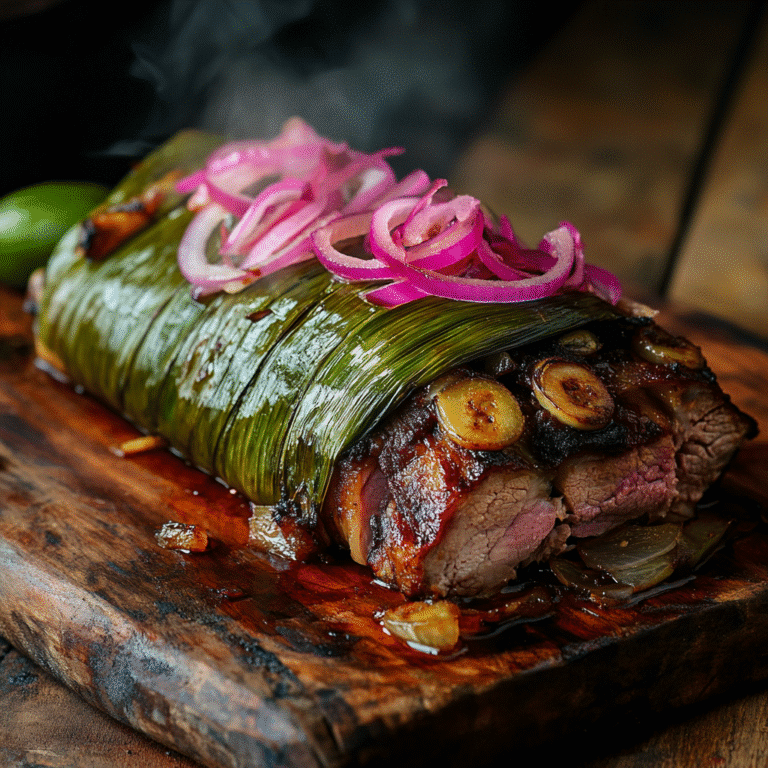Cochinita Pibil is the heart and soul of Yucatán’s culinary tradition. This slow-roasted pork dish, marinated in achiote and citrus, then wrapped in banana leaves, has traveled from ancient Mayan kitchens to modern tables across the world. If you’ve been searching for an authentic, flavor-packed Mexican dish to master at home, Cochinita Pibil is the recipe to try.
As a passionate home cook who loves sharing cultural classics, I’ve found few dishes as rewarding to prepare—and devour—as Cochinita Pibil. Its bold color, citrusy aroma, and fall-apart texture make it a favorite in my kitchen. It’s a dish that tells a story, one bite at a time.
Check out our Tacos Rojos Potosinos for another delicious regional recipe that pairs beautifully with this pork masterpiece.
In this guide, you’ll learn all about Cochinita Pibil—its history, how to make it step by step, modern twists, side dishes, and why it’s become a cultural icon. We’ll also cover how to store leftovers, common FAQs, and even what Johnny Depp has to do with this smoky, spicy pork sensation.
Table of Contents
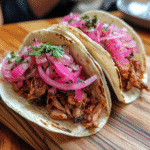
Cochinita Pibil: The Best Yucatecan Pork Dish You’ve Never Tried in 2025
- Total Time: 4 hours 15 minutes
- Yield: 6 servings
Description
Cochinita Pibil is a slow-roasted pork dish from the Yucatán Peninsula, marinated in achiote and citrus juice, then wrapped in banana leaves for a juicy, tender, and flavorful result.
Ingredients
- 3–4 lbs pork shoulder, boneless, cut into chunks
- ½ cup achiote paste
- ½ cup bitter orange juice (or ⅓ cup orange juice + 3 tbsp lime juice)
- 4 garlic cloves, minced
- 1 tsp Mexican oregano
- 1 tsp ground cumin
- 1 tsp salt
- Banana leaves (or parchment paper)
- Pickled red onions (for serving)
- Corn tortillas (for serving)
Instructions
- Mix achiote paste, citrus juice, garlic, oregano, cumin, and salt in a bowl. Add pork and coat well. Marinate in the refrigerator overnight.
- Soften banana leaves by briefly heating over a flame or in a dry pan. Line a baking dish with them, leaving overhang.
- Place pork and marinade in the dish. Fold leaves over the top and cover tightly with foil or a lid.
- Bake at 325°F (163°C) for 3.5 to 4 hours, until pork is fork-tender.
- Unwrap, shred pork in its juices, and serve with tortillas and pickled red onions.
Notes
For added authenticity, seek out frozen banana leaves at Latin or Asian grocery stores. Substitute parchment and foil if unavailable. Use the oven for the most traditional texture and flavor.
- Prep Time: 15 minutes
- Cook Time: 4 hours
- Category: Main Course
- Method: Roasted
- Cuisine: Mexican
Discovering Cochinita Pibil
What is Cochinita Pibil?
At its core, Cochinita Pibil is a citrus-marinated, slow-roasted pork dish wrapped in banana leaves and infused with achiote. The word “cochinita” refers to baby pig, while “pibil” is a Mayan term for food cooked underground. While modern kitchens have adapted the cooking methods, the rich flavor profile remains deeply traditional.
What makes Cochinita Pibil so beloved is its blend of earthy spices and tangy citrus. The result is meat that’s tender, juicy, and packed with flavor—perfect for tacos, tostadas, or simply served with rice and beans.
The Origins: A Taste of Mayan Heritage
Cochinita Pibil traces its roots back to pre-Hispanic Mayan culture, where food was traditionally cooked in a pib—an underground oven. Once pigs were introduced to Mexico by the Spanish, pork quickly became the protein of choice. Wrapped in banana leaves and buried among hot stones, this slow-cooking technique allowed the meat to absorb smoky, herbal flavors.
Even today, Cochinita Pibil remains a symbol of festive gatherings and family traditions across Yucatán. Though most of us now use ovens or slow cookers, the spirit of the pib lives on through every marinated bite.
Key Ingredients That Define Cochinita Pibil
The Role of Achiote and Bitter Orange
Two ingredients define the bold, unmistakable flavor of Cochinita Pibil: achiote and bitter orange juice.
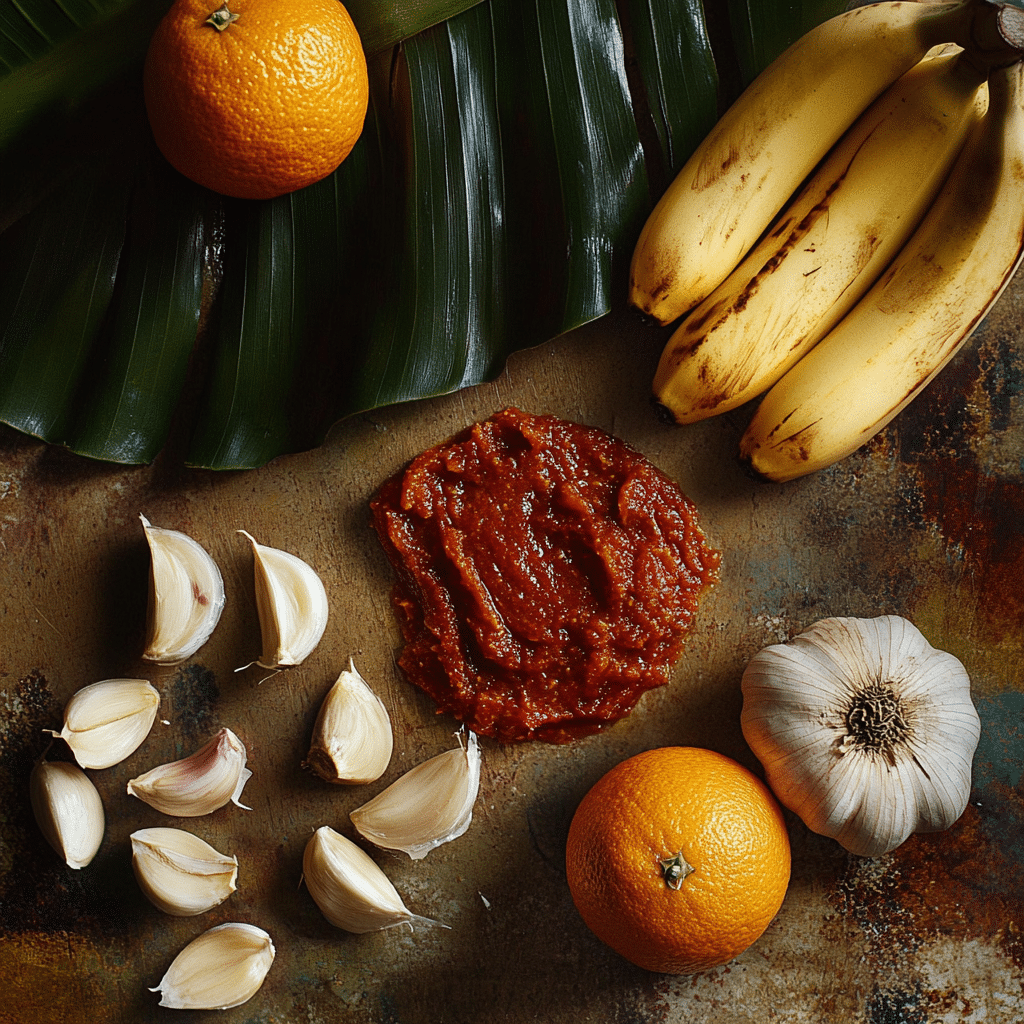
Achiote paste, made from annatto seeds, garlic, vinegar, and spices, is the deep red marinade that gives Cochinita Pibil its signature color and earthy aroma. It’s not spicy, but it’s intensely aromatic and slightly nutty, with hints of pepper and smoke. You can find achiote in Mexican grocery stores or make your own blend if you’re feeling adventurous.
The marinade wouldn’t be complete without bitter orange—known in Spanish as naranja agria. Its sour, slightly floral taste balances the richness of the pork and helps tenderize the meat during marination. If you can’t find bitter oranges in the U.S., a mix of fresh orange juice and lime juice is a perfect substitute.
Flavor tip: Combine 2 parts orange juice to 1 part lime juice for an excellent stand-in for bitter orange.
Cochinita Pibil wouldn’t be the same without this marinade. It penetrates deep into the pork, making every bite juicy and flavorful from the inside out.
Why Banana Leaves Matter in Authentic Recipes
If you want to keep things traditional, don’t skip the banana leaves. While it might be tempting to wrap your pork in foil or cook it bare in a baking dish, banana leaves do more than just hold things together—they add a subtle herbal essence and lock in moisture during cooking.
In ancient Mayan cuisine, the banana leaf wrapping was essential to the underground pib cooking technique. Today, even if you’re using an oven or slow cooker, wrapping your pork in banana leaves adds a gentle steam effect, creating that melt-in-your-mouth texture Cochinita Pibil is known for.
You can find frozen banana leaves in the freezer aisle of most Latin American or Asian grocery stores. Just thaw and wipe them clean before use.
Looking for a twist on traditional flavors? Discover great ideas like Mexican Tortilla Cinnamon Rolls for a sweet finish to your Cochinita Pibil feast.
With these key ingredients—achiote, bitter orange, and banana leaves—you’ve got the heart of Cochinita Pibil in your hands. Next, we’ll explore how to bring it all together in your own kitchen, no underground pit required.
How to Make Traditional Cochinita Pibil at Home
Step-by-Step Recipe from a Home Cook’s Kitchen
You don’t need an underground pit to make authentic Cochinita Pibil. With just a few tools and some patience, you can bring the flavors of Yucatán straight to your kitchen. Here’s how to do it:
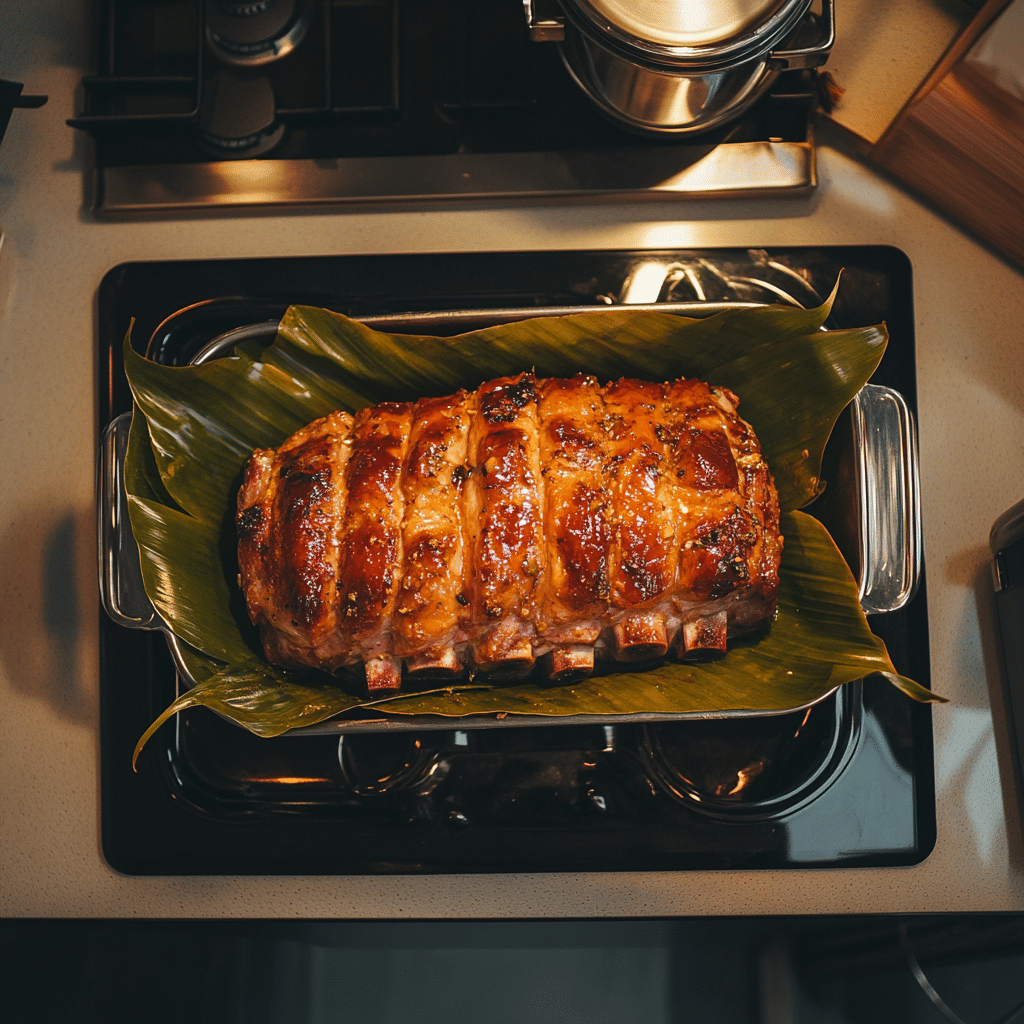
Ingredients:
- 3–4 lbs pork shoulder (boneless, cut into large chunks)
- 1/2 cup achiote paste
- 1/2 cup bitter orange juice (or substitute: 1/3 cup orange juice + 3 tbsp lime juice)
- 4 cloves garlic (minced)
- 1 tsp oregano (preferably Mexican oregano)
- 1 tsp cumin
- 1 tsp salt
- Banana leaves (or parchment paper if unavailable)
- Pickled red onions (for serving)
- Corn tortillas (for serving)
Instructions:
- Marinate the Pork
In a bowl, mix the achiote paste with bitter orange juice, garlic, oregano, cumin, and salt until smooth. Add the pork and toss to coat evenly. Cover and marinate in the fridge for at least 8 hours, ideally overnight. - Prepare the Banana Leaves
Quickly pass the banana leaves over an open flame or hot pan to soften them. Line a baking dish or Dutch oven with overlapping leaves, leaving enough overhang to fold over the top. - Wrap and Roast
Place the marinated pork and all marinade liquid in the lined dish. Fold the banana leaves over the pork to seal it. Cover with a lid or foil and bake at 325°F (163°C) for 3.5 to 4 hours until the pork is fork-tender. - Shred and Serve
Carefully unwrap the pork, shred it directly in the juices, and serve warm. It’s amazing in tacos, burritos, tortas, or just alongside rice and beans.
Don’t miss our Tortilla Cinnamon Rolls—the perfect sweet follow-up to your savory Yucatán meal.
Tips for Marinating and Slow-Roasting to Perfection
- Use a glass or ceramic bowl for marinating. The acids in the citrus can react with metal.
- Don’t skip the overnight marination—this is where the magic happens. The pork soaks up flavor and becomes unbelievably tender.
- Low and slow wins the race. Resist the urge to crank up the heat. The tenderness of Cochinita Pibil depends on gentle roasting.
- Wrap tightly. If you’re not using banana leaves, parchment paper under foil still helps trap moisture and mimic the traditional method.
With this method, you’re not just cooking—you’re connecting to centuries of tradition through one of Mexico’s most flavorful dishes. Cochinita Pibil takes time, but every bite is worth the wait.PART 4: Cooking Methods Compared — Oven, Slow Cooker, and Instant Pot
Pros and Cons of Each Method
While the traditional way to cook Cochinita Pibil involves burying it underground, modern home cooks have far more convenient options. Here’s how the oven, slow cooker, and Instant Pot stack up for preparing this beloved Yucatecan dish.
| Method | Pros | Cons |
|---|---|---|
| Oven | Best flavor + closest to traditional; great texture and caramelization | Longer cook time; needs banana leaves or tight wrapping |
| Slow Cooker | Easiest hands-off method; excellent moisture retention | Lacks crispy edges; longer wait time |
| Instant Pot | Fastest option; great for busy cooks | Slightly different texture; less flavor depth without marination |
Let’s break each one down.
Oven Method
If you want to stay true to the essence of Cochinita Pibil, the oven is your best bet. Roasting at a low temperature mimics the original underground pib, allowing flavors to deepen over time. You’ll get juicy meat with some lightly crisped edges—perfection.
Pro tip: Wrap the pork tightly in banana leaves and cover the dish well to lock in steam and moisture.
Slow Cooker Method
A slow cooker makes Cochinita Pibil incredibly easy. Simply place the marinated pork and juices into the pot and cook on low for 8 hours or high for 5–6 hours. The meat will be tender and infused with flavor, but you may miss out on the subtle roasted notes of oven cooking.
To add some texture, shred the pork and finish it in a hot pan for a few minutes before serving.
Instant Pot Method
Short on time? The Instant Pot is a lifesaver. You can pressure cook Cochinita Pibil in about 1 hour, plus time for marination and pressure release. The pork will be tender and flavorful, though not quite as complex as the slow-roasted version.
To boost flavor, use the sauté function after shredding to reduce the cooking liquid and re-coat the meat.
Don’t miss our cozy Banana Coffee Syrup**—it pairs surprisingly well with spicy dishes like Cochinita Pibil.
Each method has its perks, and your choice depends on your time, tools, and taste preference. Whether slow-roasted in an oven or sped up in a pressure cooker, Cochinita Pibil delivers deep, unforgettable flavor every time.
Cooking Methods Compared — Oven, Slow Cooker, and Instant Pot
Pros and Cons of Each Method
While the traditional way to cook Cochinita Pibil involves burying it underground, modern home cooks have far more convenient options. Here’s how the oven, slow cooker, and Instant Pot stack up for preparing this beloved Yucatecan dish.
| Method | Pros | Cons |
|---|---|---|
| Oven | Best flavor + closest to traditional; great texture and caramelization | Longer cook time; needs banana leaves or tight wrapping |
| Slow Cooker | Easiest hands-off method; excellent moisture retention | Lacks crispy edges; longer wait time |
| Instant Pot | Fastest option; great for busy cooks | Slightly different texture; less flavor depth without marination |
Let’s break each one down.
Oven Method
If you want to stay true to the essence of Cochinita Pibil, the oven is your best bet. Roasting at a low temperature mimics the original underground pib, allowing flavors to deepen over time. You’ll get juicy meat with some lightly crisped edges—perfection.
Pro tip: Wrap the pork tightly in banana leaves and cover the dish well to lock in steam and moisture.
Slow Cooker Method
A slow cooker makes Cochinita Pibil incredibly easy. Simply place the marinated pork and juices into the pot and cook on low for 8 hours or high for 5–6 hours. The meat will be tender and infused with flavor, but you may miss out on the subtle roasted notes of oven cooking.
To add some texture, shred the pork and finish it in a hot pan for a few minutes before serving.
Instant Pot Method
Short on time? The Instant Pot is a lifesaver. You can pressure cook Cochinita Pibil in about 1 hour, plus time for marination and pressure release. The pork will be tender and flavorful, though not quite as complex as the slow-roasted version.
To boost flavor, use the sauté function after shredding to reduce the cooking liquid and re-coat the meat.
Don’t miss our cozy Banana Coffee Syrup**—it pairs surprisingly well with spicy dishes like Cochinita Pibil.
Each method has its perks, and your choice depends on your time, tools, and taste preference. Whether slow-roasted in an oven or sped up in a pressure cooker, Cochinita Pibil delivers deep, unforgettable flavor every time.
Serving Ideas and Side Dishes
What to Serve with Cochinita Pibil
Cochinita Pibil isn’t just a main dish—it’s the star of the table, and it deserves a supporting cast of vibrant, flavorful sides. Whether you’re planning a family dinner or entertaining friends, the right sides will elevate this dish from great to unforgettable.
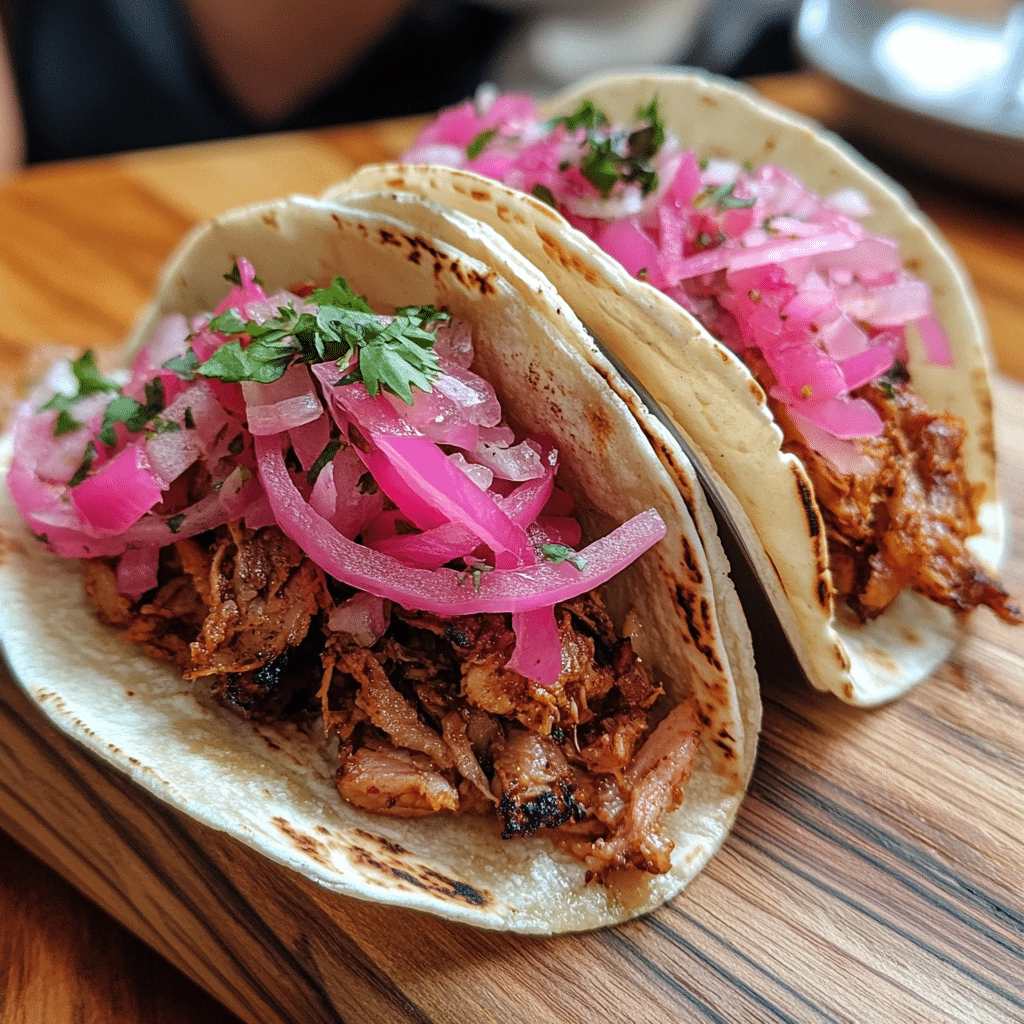
Here are some classic and creative sides that pair beautifully with Cochinita Pibil:
- Pickled Red Onions: A must-have. Their sharp tang cuts through the rich pork beautifully.
- Mexican Rice: Mildly seasoned rice acts as the perfect neutral base.
- Refried Black Beans: Earthy and creamy, they offer balance.
- Tostones or Fried Plantains: Adds sweetness and texture.
- Grilled Corn with Lime: Bright, smoky, and zesty—an amazing contrast to the savory pork.
A side of citrus-dressed slaw or even avocado slices with lime and salt can also freshen things up.
Looking for inspiration? Try Mexican Tortilla Cinnamon Rolls for a sweet twist after your Yucatán feast.
Taco Time: Tortillas, Pickled Onions & More
Let’s be honest—Cochinita Pibil tacos are one of the best ways to enjoy this dish. Warm up some corn tortillas, pile on that juicy pork, and top with pickled red onions and a sprinkle of fresh cilantro. Maybe a squeeze of lime or a touch of habanero salsa if you’re brave.
Here’s how to build the ultimate Cochinita Pibil taco:
- Warm tortilla (corn is best for authenticity)
- Shredded Cochinita Pibil with its juices
- Pickled red onions
- Fresh cilantro and lime
- Optional: spicy habanero salsa or avocado slices
Want something more filling? Try making a torta—a Mexican sandwich—using a crusty roll, layered with pork, beans, and slaw.
These simple yet flavor-packed combos are what make Cochinita Pibil such a crowd-pleaser. With the right side dishes and taco essentials, you can turn a slow-roasted dish into a full Mexican street-food experience right at home.
Cochinita Pibil vs Carnitas — What’s the Difference?
Flavor Profiles and Cooking Styles
Although both Cochinita Pibil and carnitas are beloved Mexican pork dishes, they couldn’t be more different in flavor, preparation, and cultural roots.
Cochinita Pibil is a Yucatecan specialty made by marinating pork in achiote and citrus juice, wrapping it in banana leaves, and slow-roasting it until the meat is fall-apart tender. It’s all about deep, earthy flavors, a hint of tang from the bitter orange, and the unmistakable red hue from the annatto seeds.
On the other hand, carnitas hail from Michoacán and are cooked in an entirely different way—typically braised or simmered in lard until the pork is tender and then crisped up at the end. Carnitas are rich, savory, and sometimes slightly caramelized, but they lack the citrusy, spiced complexity of Cochinita Pibil.
| Feature | Cochinita Pibil | Carnitas |
|---|---|---|
| Region | Yucatán | Michoacán |
| Main Flavor Base | Achiote, citrus, garlic | Pork fat, herbs, salt |
| Cooking Method | Slow-roasted in banana leaves | Braised then crisped in lard |
| Texture | Juicy, tender, steamed | Crispy edges, soft inside |
| Color | Deep red-orange | Light brown/golden |
So while both are forms of Mexican pulled pork, the seasoning, texture, and history behind each dish set them apart. Comparing Cochinita Pibil vs carnitas is like comparing jazz and rock—each has its own rhythm, but both deliver a great performance.
Cultural Background and Culinary Identity
Cochinita Pibil tells the story of the Mayan people, their cooking traditions, and their connection to the land. It uses local ingredients like bitter orange and banana leaves, which are central to the region’s identity.
Carnitas, meanwhile, represent the central-western regions of Mexico, where pork has long been central to festive gatherings and street food culture. They’re often served at celebrations like weddings, birthdays, and local fairs.
Understanding these cultural roots helps us appreciate why both dishes are celebrated—but also why Cochinita Pibil deserves its own spotlight as a distinct and deeply traditional dish.
Cochinita Pibil in Pop Culture and Modern Kitchens
Johnny Depp’s Cochinita Moment in Once Upon a Time in Mexico
If you’ve seen the action-packed film Once Upon a Time in Mexico, you probably remember a very specific scene: Johnny Depp’s character, Agent Sands, orders Cochinita Pibil in nearly every restaurant he visits. He’s obsessed with it—so much so that he goes on a mission to eliminate every chef who makes it “too well.”
Sounds dramatic, right? That quirky plotline brought Cochinita Pibil into mainstream consciousness, especially in the United States, where many viewers heard about the dish for the first time. After the movie, searches for the term skyrocketed, and the dish started showing up on more restaurant menus outside of Mexico.
What was once a deeply regional specialty suddenly had the attention of foodies and film buffs alike.
Looking to recreate that rich, cinematic flavor at home? Start with a traditional marinade, wrap in banana leaves, and roast low and slow—you’ll taste what Johnny Depp’s character couldn’t resist.
How the Dish Gained Global Fame
The exposure in pop culture sparked a wave of curiosity about Cochinita Pibil, and chefs around the world took notice. Today, you’ll find elevated versions in modern Mexican restaurants, street food trucks, and even fine dining establishments.
But beyond the glamor of Hollywood, home cooks have embraced Cochinita Pibil for its authenticity and depth of flavor. With more accessible ingredients—thanks to online retailers and Latin grocery stores—it’s easier than ever to bring this slow-roasted pork to your own dinner table.
And the versatility doesn’t hurt. Whether in tacos, burrito bowls, enchiladas, or even sliders, Cochinita Pibil adapts beautifully to contemporary kitchens without losing its traditional soul.
Modern twists include:
- Using an Instant Pot for quicker prep
- Serving with quinoa or roasted veggies instead of rice
- Making vegan versions with jackfruit marinated in achiote
This dish proves that ancient flavors can still steal the show—even in today’s fast-paced culinary world.
Taste, Texture, and Aromatics
What Does Pibil Taste Like?
If you’ve never tried Cochinita Pibil, imagine a fork-tender pork shoulder bathed in bright citrus, warm spices, and the earthy essence of banana leaves. The taste is unlike any other pork dish—it’s tangy, savory, and slightly smoky, all at once.
The achiote marinade is the flavor backbone. Annatto seeds lend an earthy, almost peppery warmth, while the bitter orange cuts through the richness of the meat with just the right amount of acidity. Combined, they create a complex, layered taste that feels both exotic and deeply comforting.
Here’s a closer look at the primary flavor notes in Cochinita Pibil:
| Flavor Element | Description |
|---|---|
| Tangy Citrus | From bitter orange or lime-orange mix |
| Earthy Achiote | Nutty, slightly peppery base |
| Herbal Warmth | Hints of oregano, garlic, and cumin |
| Subtle Sweetness | Natural from pork, amplified by roasting |
| Smoky Banana Leaf | Light, green, tea-like finish |
The result? A dish that hits sweet, sour, salty, and umami in every bite—perfectly balanced.
How Aromatics Influence the Overall Flavor
The fragrance of Cochinita Pibil is just as iconic as its taste. From the moment you unwrap the banana leaves, the aromas hit you with a symphony of scents: citrus, garlic, and spices mingling with the warm steam rising from the pork.
Aromatics like garlic, onion, cumin, and oregano are foundational to the dish’s depth. They don’t just add complexity—they build anticipation. When roasting, your kitchen fills with the scent of spiced pork and herbs, creating a sensory experience that’s half the fun.
Even the banana leaves contribute to the smell, adding a subtle grassy aroma that rounds out the dish with a natural touch.
This aroma-rich experience is why Cochinita Pibil often becomes a showstopper at gatherings. It smells like something special before you even take a bite.
Cochinita Pibil Tips, Storage & Leftovers
How to Store and Reheat Without Losing Flavor
One of the best things about Cochinita Pibil—besides how delicious it is fresh—is how well it holds up as leftovers. In fact, many say it tastes even better the next day.
Here’s how to store and reheat it properly:
Storage:
- Allow the pork to cool completely before storing.
- Place shredded Cochinita Pibil and its juices in an airtight container.
- Store in the refrigerator for up to 4 days.
- For longer storage, freeze it (with juices) for up to 3 months.
Reheating:
- On the stove: Reheat slowly in a skillet over medium heat, adding a splash of water or orange juice to loosen it up.
- In the oven: Cover with foil and reheat at 300°F for 15–20 minutes.
- In the microwave: Use medium power in short bursts to avoid drying it out.
Avoid overheating—the pork is already tender and doesn’t need to be cooked further, just warmed through.
Creative Ways to Use Leftover Cochinita
Leftover Cochinita Pibil is a goldmine for second-day dishes. Here are a few creative ways to repurpose it without feeling like you’re eating the same meal twice:
- Pibil Quesadillas: Load tortillas with pork and cheese, toast until golden, and serve with salsa.
- Burrito Bowls: Layer over rice with beans, avocado, and grilled veggies.
- Torta Sandwiches: Stuff crusty rolls with Cochinita, pickled onions, and spicy mayo.
- Stuffed Peppers: Mix pork with rice and stuff into bell peppers, then bake.
- Nachos: Top tortilla chips with cheese, shredded pork, and broil. Finish with crema and jalapeños.
Want more flavor-packed inspiration? Don’t miss our Tortilla Cinnamon Rolls for a creative way to finish your meal on a sweet note.
So go ahead—make a big batch of Cochinita Pibil. Your future self will thank you.
Conclusion: Why Cochinita Pibil Belongs in Every Home Cook’s Repertoire
From its deep Mayan roots to its modern-day pop culture fame, Cochinita Pibil is more than just a dish—it’s a culinary journey. Whether you’re wrapping pork in banana leaves or adapting the recipe to a weeknight Instant Pot dinner, the heart of this Yucatecan treasure stays intact: rich flavor, bold colors, and tradition you can taste.
This guide walked you through everything—ingredients, methods, flavors, comparisons, serving tips, and even movie trivia. Now it’s time to roll up your sleeves and make Cochinita Pibil your own.
Learn more about regional flavors in our Tacos Rojos Potosinos or get creative with sweet finishes like Mexican Tortilla Cinnamon Rolls and Banana Coffee Syrup.
Frequently Asked Questions About Cochinita Pibil
What is the Cochinita Pibil?
Cochinita Pibil is a traditional Yucatecan dish made from pork marinated in a blend of achiote paste, citrus juices (usually bitter orange), and spices, then wrapped in banana leaves and slow-roasted until tender. The name translates to “baby pig cooked underground,” referring to its Mayan roots and original pit-cooking method. It’s known for its vibrant red color and bold, tangy flavor.
Is Cochinita Pibil the same as carnitas?
No, Cochinita Pibil and carnitas are completely different dishes, although both involve pork. Cochinita Pibil uses achiote and citrus for its marinade and is slow-roasted in banana leaves, often yielding a juicy, earthy, and slightly tangy result. Carnitas, on the other hand, are braised in lard, then crisped for texture, and have a richer, fattier flavor without the citrusy or herbal notes.
What dish does Johnny Depp eat in Once Upon a Time in Mexico?
In Once Upon a Time in Mexico, Johnny Depp’s character is obsessed with Cochinita Pibil. The dish becomes a running theme in the movie, with Depp’s character claiming he eliminates any chef who makes it too well. This cult-favorite scene introduced many viewers around the world to the dish and sparked curiosity about its bold flavor and cultural significance.
What does Pibil taste like?
Pibil has a distinctive and complex flavor. It’s tangy from the citrus, earthy from achiote, and lightly smoky due to its traditional banana leaf wrapping. The meat is juicy, tender, and aromatic with notes of garlic, oregano, and cumin. Each bite of Cochinita Pibil delivers layers of bright, savory, and slightly sweet flavors that linger on the palate.
Follow us on Facebook for fresh new recipes, cooking tips, and food inspiration every week!

